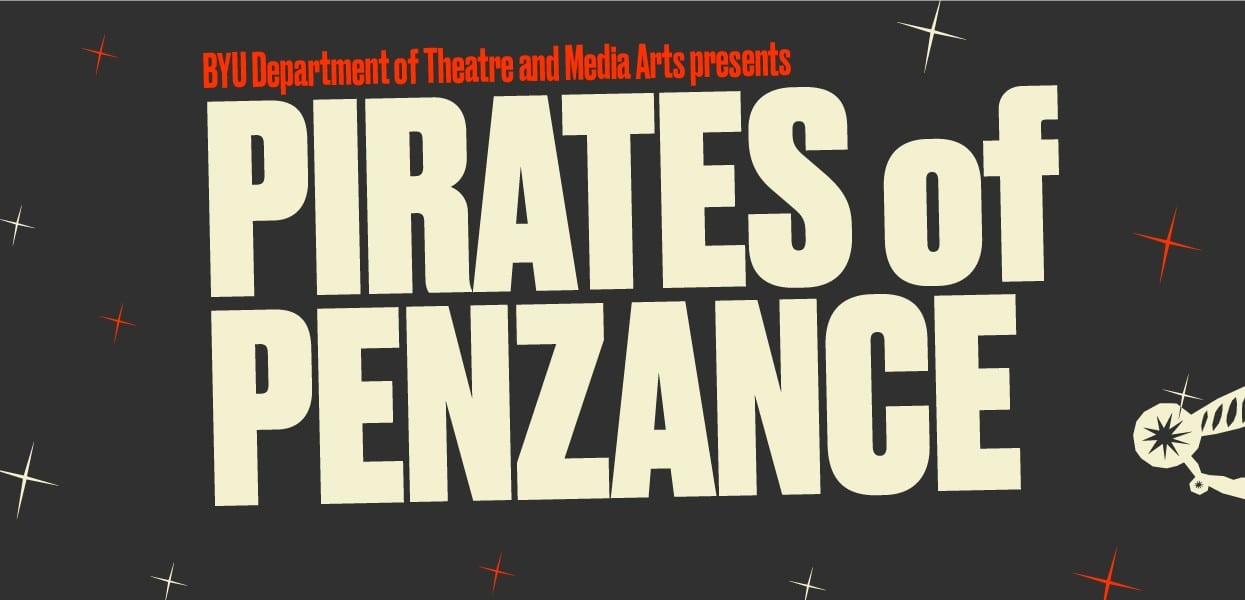PROVO — How do you fill a stage with two dozen actors when you’re not allowed to have more than four near each other? That’s the challenge presented to the BYU Theatre and Media Arts Department for their presentation of selections from Gilbert and Sullivan’s immortal The Pirates of Penzance.

The answer is complicated. And amazing.
First, all the actors pre-recorded their dialogue and singing. Then the stage was taped off into 5 sections (or pods) where actors were placed for large group numbers. After the performance was lip-synced, the stage was digitally stitched together in post-production. It’s like that old splitscreen trick when a character in a tv show clones themself and appears in the same scene twice. Except it’s an entire production like that and it’s five clones, not two.
Much like the last livestream play from BYU I reviewed (Manual for a Desperate Crossing), the technical nature of The Pirates of Penzance is a marvel. The fact it worked on any level is amazing.
The familiar opera features a young man named Frederic on the day he ages out of pirate service. It is not long (especially in this is a condensed version) before he stumbles upon a boat full of women and their doting major general daddy. The opera, written in 1879, holds up well for modern audiences. The only really dated reference I caught in this condensed performance was the phrase “sat a gee,” which means “sat on a horse.”
The Pirates of Penzance is one of the funniest and most enduring things ever put on stage. In the 21st century, funny pirates are their own comedy subgenre, from The Pirates of the Caribbean franchise to Monkey Island, Muppet Treasure Island, and the underappreciated claymation The Pirates! A Band of Misfits. Without The Pirates of Penzance, none of that silly swashbuckling would likely exist.
BYU’s production of this classic was an unusual production, to say the least. With all the technical hurdles BYU’s production had to overcome, it deserves every benefit of the doubt in the world. Still, there are a couple choices that held it back. The first was breaking the opera into nine sections with a unique cast for each. The reason for this was to give more students an opportunity to perform, which is a noble goal for an educational institution, even if it does not work in the audience’s favor. The solo piano accompaniment and lack of costuming were also disappointing, but this may have been inevitable because of the on-campus restrictions.
While the acting and singing of many of the actors who played Frederic, including Brendon French and Cagen Tregeagle, were impressive, the best performance of the show was Rachel Peterson’s “Poor Wondering One.” The control, the power, the breath support, and the purity of her operatic voice were incredible. Her high notes and staccato were thrilling. Later Mabel, played by Hannah Hagues (at least, I think it was Hagues; the frequent cast changes and setlist-free program make it difficult to know for sure) also had a delicate, yet powerful, voice that conveyed a fairy quality in her singing.
Speaking of singing, the chorus of women sounded great, but the men in the company did not hold up as well. Some of the Frederics struggled with their singing and need more practice to develop an operatic singing style. I would have preferred one man to be cast who could handle the score.
Gunnar Russell certainly stood out as Sergeant of Police. Upon taking the stage, he made an immediate impression with his severe, erect and precise body movements. His distinctive physical performance was close to clown or mime work. I have not seen anything onstage quite like it before, but a silly part in a silly comedy seems a good fit.
When the pre-recorded dialogue started, I had a sinking feeling in my stomach that it was going to be a long night. But it did not bother me after a while. Everyone from cast to crew did an excellent job considering the restraints on this production. With all movement and choreography (by Kori Wakamatsu) constricted to small boxes onstage, the production certainly looked unusual. While I do not recommend theater companies to adopt this staging as a creative choice post-Covid, everyone did their best given the crazy circumstances.
I cannot imagine the logistical puzzles director Tim Threlfall and crew had to solve in order to stitch together a performance like this. While this production left me longing for a more traditional production of the classic opera (and to be part of a laughing audience once again), BYU’s The Pirates of Penzance was a fine Covid-era achievement.
[box]The Brigham Young University production of The Pirates of Penzance plays nightly at 7:30 PM through April and can be viewed online at tma.byu.edu. There is no cost to viewing the production. For more information, visit arts.byu.edu.[/box]
